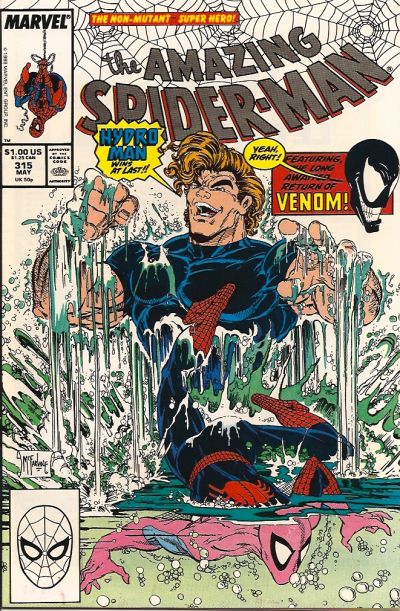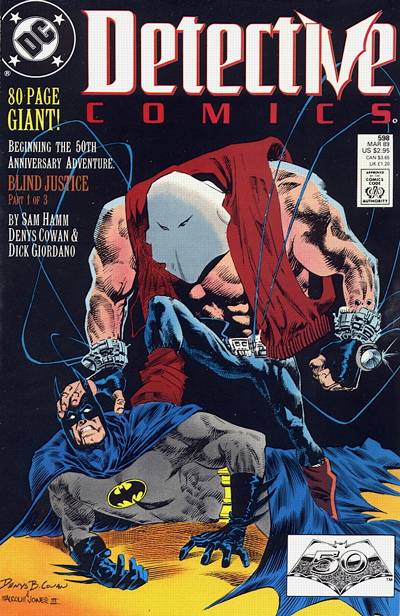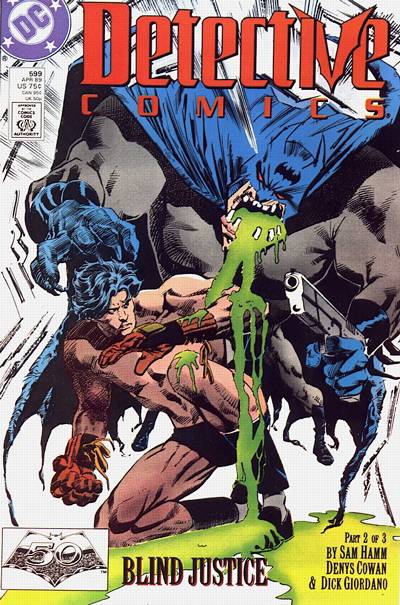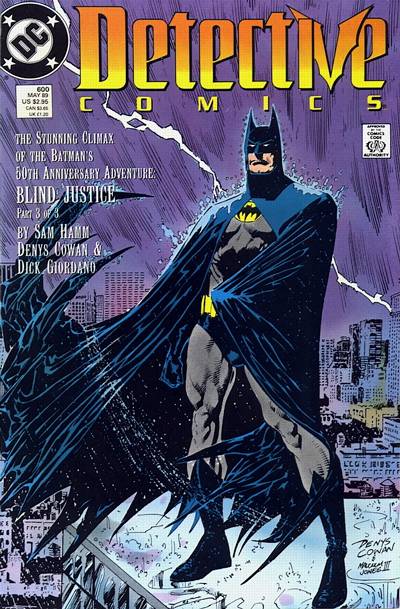Completing my freshman year at University of Arizona, I returned to Scottsdale for the summer. I think I took a short visit back to Edmonton, and then returned to Scottsdale and secured a summer job in the engineering department at the Hilton Scottsdale Resort & Villas, located at 6333 N. Scottsdale Road. I remember getting my first check and heading to the comics shops, the closest of which that I knew to be a good one was AAA Best Comics, located at 9204 N. Seventh St. in Phoenix.
This was the shop to which Fog Hollow transferred its subscription accounts when it closed the year before. I don’t remember much about my single visit to the store the year before, but I do remember pulling up to AAA Best on a sunny morning in June 1988 and walking in to find an older woman sitting by the door and announcing to her son, the owner, that he had a customer. The man was Ken Strack, and he was a terrific comic shop owner who earned a lot of my business for the next five or six years.

On that day, Ken was busy sorting and the new issues were just laid out on a table in near the front entrance. The store occupied a long and narrow space at the end of a strip mall structure. I distinctly recall Excalibur #1 was just out and I scooped it up ASAP to flip through the lovely artwork by Alan Davis and Paul Neary. The other book I recall grabbing, either on that visit or one shortly thereafter, was Marvel Comics Presents #1, with that cool Walt Simonson wrap-around cover.

This also was the summer when Marvel experimented with twice-monthly publication of its top titles, which included X-Men and The Amazing Spider-Man. The latter was, of course, drawn by Todd McFarlane and was taking off like a rocket.
I still visited other stores, most notably All About Books & Comics, during this time. But AAA Best was my favorite. Ken was quick to spark a discussion and recommend new books based on what he knew you liked. I looked forward to visiting the shop as much to talk with him about comics as to buy my weekly stash. I once was checking out with a large stack and as he rang them up, I said it should keep me busy for a week or so. His reply was something along the lines of “No way! You gotta grab a bowl of cereal and stay up all night reading them!”
I kept my subscriptions with AAA Best even when I went back to school in Tucson that fall for my sophomore year. I had a new place to live in a different part of town, but I also had a car and a girlfriend I met in traffic school that summer. She was starting as a freshman at U of A, but I was so insecure about my comics habit that I didn’t tell her about it until we’d been dating a few months already. I need not have worried. She thought it was kind of cool and even read some of the books — she liked McFarlane’s Amazing Spider-Man — when I’d acquire a new stack of stuff.
I had braces at this time, and at least once a month would come up to Scottsdale to have the orthodontist adjust them. He had office hours on Saturday morning, so after my appointment, I’d head over to AAA Best. One day in January 1989, Ken was on the phone when I walked into the store. He was having an animated conversation with someone about flying in for an event, weekend accommodations, etc. At the end, he pulled out a copy of The Amazing Spider-Man, #315, which was the most-recent issue at the time, to look up the circulation figures in the statement of ownership in the back, and said he’d be happy to pop a few copies in the mail. That was when I realized he was talking to the one and only Todd McFarlane. When Ken hung up, he looked at me and said, “You are sworn to secrecy!” He then told me that McFarlane was coming for a store signing that spring and that subscribers like myself would get a special poster signed by Todd, whether they could make the event or not. This was quite exciting news, to be sure, but it was easy to keep to myself since I knew almost no one who would have known who McFarlane was.

He says at the end that he ultimately wants to do a gag strip like Garfield.
The signing itself was March 25, 1989 — a Saturday. There was an article with and interview with McFarlane on the front of the Life & Leisure section of The Arizona Republic newspaper on March 23, 1989, promoting the signing and, when I arrived fairly early on there was already a long line of folks ready to meet Todd. It took a long time, and I’m glad this was March instead of July. Todd at one point agreed to take a short break to review the portfolios of artists looking for feedback. But eventually, I got to the front of the line. Todd was sitting at a table in the back of the shop, with a stack of original Spider-Man art that was for sale, as well as copies of most of his books for sale at then-relevant prices. I regret not buying any of that art, but at the time $75 or $100 a page was out of my price range. I remember the guy in front of me bought a copy of The Incredible Hulk #340 for $10, and Todd teased him by saying he could buy 10 Spider-Mans instead for the same price.

I got my copy of The Amazing Spider-Man #300 signed — I’d never been to a signing before and hadn’t thought to bring more than the one comic for him to sign! He also signed the poster the store had printed up. That poster now hangs, framed, quite visibly near the dining table in my house.

That summer, I worked again in Phoenix at American Express — this time tracking down, repairing and cleaning credit-card authorization. Not very exciting — and sometimes quite disgusting — but it did put me in position to visit All About Books & Comics and then swing by AAA Best on the way home. I remember buying a copy of Marvel Graphic Novel #5: X-Men — God Loves, Man Kills that summer at AAA Best, and being completely blown away by it.
And for those who don’t remember or weren’t there yet, 1989 was a huge summer for movies, starting with the release in May of Indiana Jones and the Last Crusade and followed by Star Trek V: The Final Frontier, License to Kill, Ghostbusters II and, of course, Tim Burton’s Batman. The rest of the summer was pretty good too, with Lethal Weapon 2 and James Cameron’s The Abyss. It was all very exciting at the time, even though most of those movies haven’t held up especially well. (One thing to remember is there was a writer’s strike in Hollywood in 1988 that limited rewrites on a lot of those movies, including most notably Batman and Star Trek V. The TV networks were so starved for cash, they started re-shooting old Mission: Impossible scripts as a new series, and Star Trek: The Next Generation used a few scripts that were originally written 10 years prior for the never-made Star Trek: Phase II series that eventually became Star Trek: The Motion Picture.)
The runaway success of Batman showed a comic-book property could result in a good movie and make a ton money at both the box office as well as with sales of T-shirts, toys, books and comics. The teaser trailer Warner Bros. released in early 1989 got everyone very excited and Batman comics started selling in big numbers, picking up lots of new readers. New comics at the time were still only 75 cents or $1, so they were cheap enough for kids excited by the movie to buy and read.
The movie came out at a good time for DC Comics, which had been doing right by Batman for a few years with things like The Dark Knight Returns, Batman: Year One, Batman: Year Two, Batman: Ten Nights of the Beast and Batman: A Death in the Family. DC’s investment in quality was really paying off for them.
Leading into the movie was DC’s celebration of Batman’s 50th anniversary with a really terrific story in Detective Comics #598-600 that was written by the new movie’s scripter, Sam Hamm, and drawn by Denys Cowan and Dick Giordano. (That writer’s strike idled Hamm, who I recall reading was quite pleased he was being paid to write comics when there were no movie or TV work to be had.) Issues #598 and 600 were 80-page giants, featuring lots of tributes in the back to Batman from top artists and writers in comics and beyond. I remember how impressive it was that the likes of Ray Bradbury and Stephen King, along with the unexpected tribute from Stan Lee, had classed up those books.
There also was a booming business in selling trade paperbacks of The Dark Knight Returns and Batman: Year One. And Alan Moore and Brian Bolland’s Batman: The Killing Joke was also in the mix, proving endlessly popular that summer with a spot-on $3.50 cover price because it was the closest of any of them to the movie’s plot.
And the public interest was extremely intense. Demand was so high for Batman T-shirts that there was a worldwide shortage of black cotton. (I read this in Variety years later in an article interviewing the then-head of Warner Bros. Consumer Products, but I don’t have the specific citation.) Every newspaper, TV station and radio outlet was doing something Batman related, from interviewing fans to “morning zoo” DJs joking about what kind of sound-effect would appear on screen when Bruce Wayne and Vicki Vale got intimate.
I was late to the game on Batman comics, but Ken set me up with trade paperbacks and enough recent issues of Detective Comics and Batman to keep me happy. This was my first regular pathway into DC Comics, which were really strong in those first few years after the reset of Crisis on Infinite Earths. I discovered the Justice League comics by Keith Giffen and J.M. DeMatteis, and loved that affectionate and funny take on superheroes. I tried stuff like Emerald Dawn, which relaunched Green Lantern, but it didn’t take with me.
Marvel was, of course, still going strong with all the Spider-Man, X-Men, The Punisher, Silver Surfer and Avengers titles. I also really dug Marvel Comics Presents, an anthology that exposed me to a lot of characters I hadn’t read before, including Black Panther in an excellent 25-part serial by Don McGregor and Gene Colan.
When I went back to Tucson that August for school, I again had a new place to live, in a new part of town. I also had broken up with my girlfriend and was now intent on majoring in journalism. I don’t know why I stopped getting my new comics from AAA Best, but it was a temporary situation, to be sure.
More to come …














































